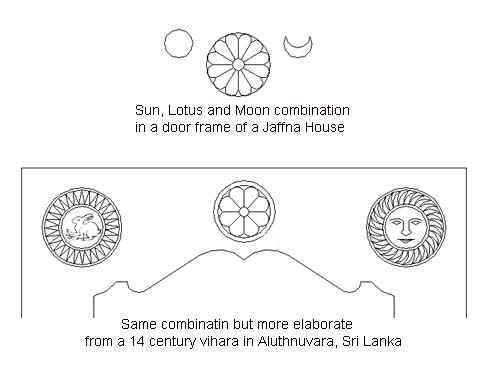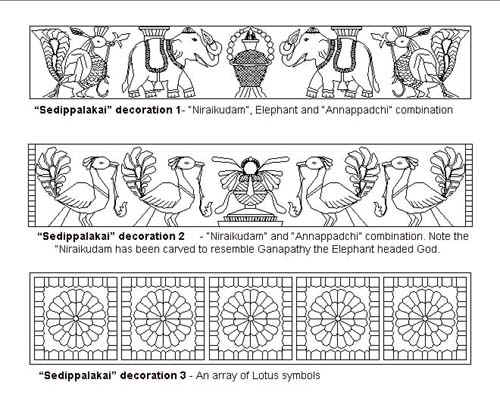 |
 |
|||||||||||||||||||||||||||||||||||||||||||||||||||||
|
Traditional Entrances and Decoration - 1The discussion in the earlier chapter reveals that certain occasional practices performed at the entrances of houses are based on concepts which are related to religious beleives and customs. These can be summerised into the following points.
Such concepts related to the relationship between house and the prosparity of the residents, hospitality, religious believes etc. reflected in the permanent decoration of the entrance doors of the Traditional houses too. Fig. 1 shows the elevation of a traditional door indicating its various components.
Doors of the earlier types represented by vannarponnai houses had very thick solid timber door frames with groups of mouldings carved on it. These were generally double doors and decorated. Above the door sashes there is a narrow horizintal decorated plank named as "sedippalakai". This plank was generally carved with various auspicious symbolic representations.
Some of the most frequently found motifs at the entrances to the Jaffna Tradutional Houses are:
Symbols depicting Sun and Moon also have been noticed in some houses. Fig.2 and 3 shows variations of some of these symbols as found in the Jaffna Traditional Houses.
It should be noted that all these are very common symbols found in Hindu and Buddhist art and architecture of India and Sri Lanka. It is interesting to note that some of these symbols had been used in medieval buildings of Southern Sri Lanka in the same manner and combination as used in Jaffna Houses. This does not mean that the Jaffna buildings had been influenced by Southern Sri Lankan buildings. In fact during medieval times South India, specifically, Tamilnadu had a strong influence on the art and architecture of the Sinhalese of Sri Lanka. It is also safe to assume that the same influence would have been there on Jaffna buildings too. However after the fall of Jaffna kingdom to Portuguese and the subsequent Dutch rule would have wiped out the Hindu
relegious art from Jaffna. Therefore any continuity from previous period on this aspect can be easily rulled out. The Jaffna houses, which we are talking about now, had been built during British period, based on the style that reentered Jaffna from Tamilnadu after a long 175 year suppression of Hindu relegious art under the first two Europeon rule. Most probably this revival could have been coincided with the building of Temples, including Vannarponnai Vaiththeeswaran Temple, with heavy cultural and personnel support from Tamilnadu during the last years of Dutch rule.
The above symbols are usually found in combination on "sedippalakai", generally with a central figure combined with other secondary auspicious symbols. The main figure is always a symbol of prosparity, such as "Gajalaxmi", "Niraikudam" etc. . These two figures too are very commonly found in South India including the doors of Mysoor palace, simllar features are found in several medieval Sri Lankan entrance door ways as well.
|
|||||||||||||||||||||||||||||||||||||||||||||||||||||
| Last updated on 30 January 2005 | ||||||||||||||||||||||||||||||||||||||||||||||||||||||
YOUR VISITOR NO. TO THIS SITE IS  THANK YOU. THANK YOU. |
||||||||||||||||||||||||||||||||||||||||||||||||||||||





